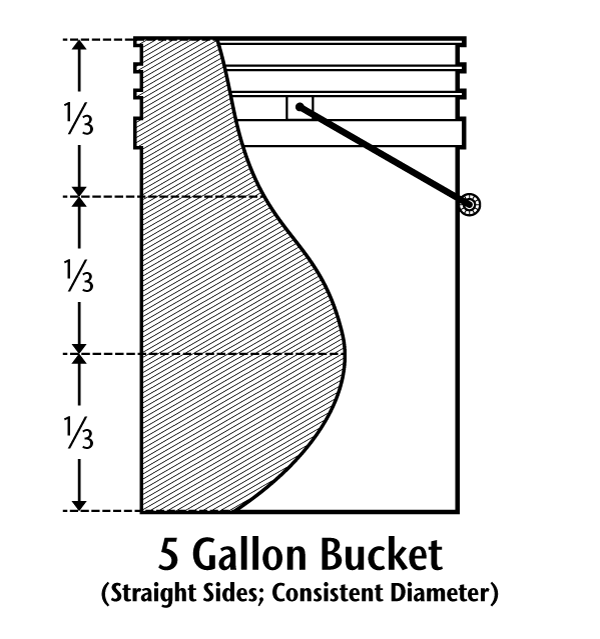Washington State University - Puyallup
Organic Farming Systems and Nutrient Management
Calculating Compost Bulk Density
♣ Download a PDF copy of this document.
Procedure for calculating compost bulk density
- With a 1-gallon measuring container, fill a 5-gallon bucket with 5 gallons of water, as the top brim of a “5 gallon bucket” is often more than 5 gallons. Mark this line on at least three places on the inside of the bucket with a permanent pen.
-
- Buckets with straight sides (ie diameter at the top of the bucket is the same as the diameter at the bottom): measure height from bottom of inside of bucket to the 5 gallon line, divide this number by 3, and mark the inside of the bucket as above at 1× and 2× this number. For example, if the 5-gallon mark is 13 inches, dividing by 3 will get 4.33 inches, so mark that bucket at 4.33 inches and 8.67 inches.
- If you cannot obtain a bucket with straight sides: find the two intermediate lines by measuring 1 ⅔ gallons (=1.67 gal or 6.31 liters or 1 gallon plus 10 ⅔ cups) then 3 ⅓ gallons (=3.33 gallons or 12.62 liters or 3 gallons plus 5 ⅓ cups) of water into the bucket and marking the inside of the bucket where the water line is at both volumes with a pencil when wet, then a permanent pen when dry.
- Compost used should be representative of the pile. Take handful samples (not large shovel full samples) from several locations in the pile. Dig into pile a couple of feet, do not take from dried-out outer layer of pile unless the pile was just turned.
 Fill bucket to the ⅓ line with compost. Drop bucket squarely from approximately 1 foot high to the ground (hard surface) 10 times. Use gravity to drop the bucket, not force.
Fill bucket to the ⅓ line with compost. Drop bucket squarely from approximately 1 foot high to the ground (hard surface) 10 times. Use gravity to drop the bucket, not force.- Fill bucket to the ⅔ line. Drop bucket squarely from approximately 1 foot high to the ground 10 times.
- Fill bucket to the ³⁄₃ (5 gallon) line. Drop bucket squarely from approximately 1 foot high to the ground 10 times.
- Fill bucket again to the ³⁄₃ (5 gallon) line (do NOT drop bucket!) and weigh in pounds.
- Multiply weight of material in pounds (excluding bucket weight) by 40. This is your bulk density, in pounds per cubic yard (lbs/yd³).

